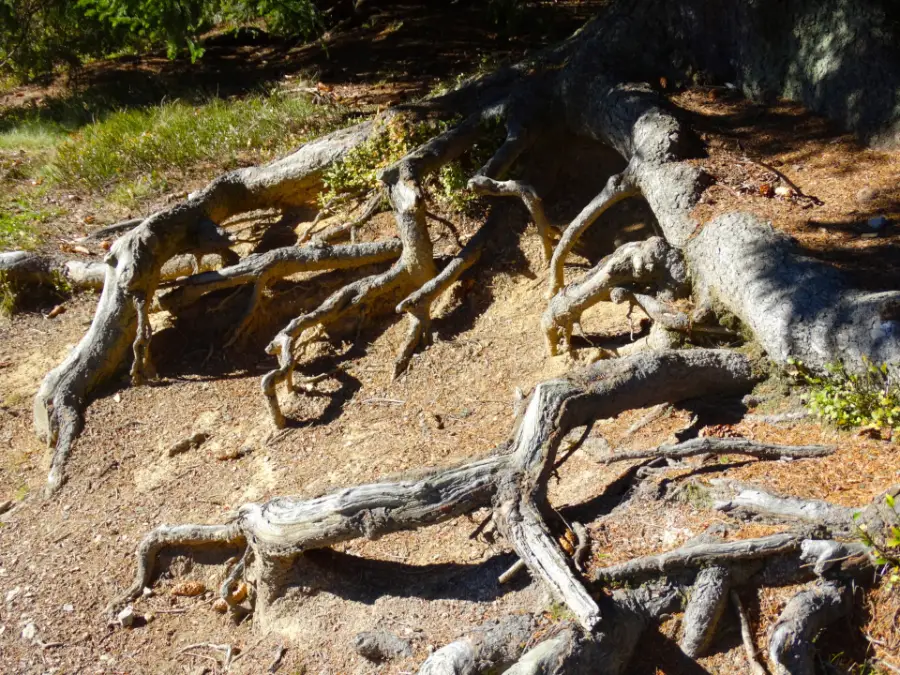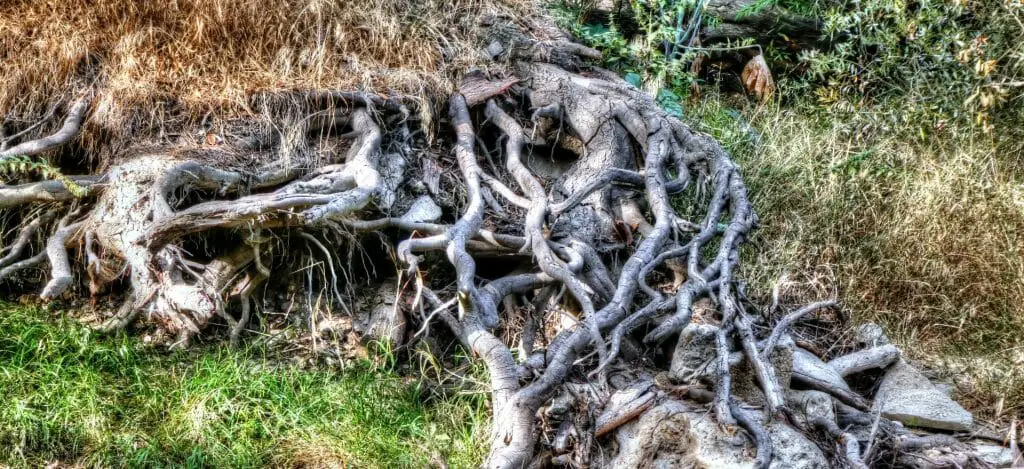Last Updated on January 16, 2023 by Grow with Bovees
When we think of tree roots, we often think of roots that have grown deep down into the soil to give our trees the solid foundation on which they stand.
While this is typically the case, tree root systems can also spread out from below the tree rather than grow down deep into the soil.
When this happens, tree roots can show up at the surface of the ground, ruining our lawn, new plants, causing soil erosion and potentially also damaging your lawn mower as well as taking soil nutrients away from grass and other plants.
Surface roots or shallow roots can also damage sidewalks, even though the foundation will form some kind of root barrier, tree roots have the power to break through these concrete root barriers.
Apart from causing soil erosion and disrupting the lawn, tree roots above the surface of the soil also make for a dangerous tripping hazard for any oncoming foot traffic.
In this article, we will go through some tree care tips that are helpful when wanting to stop roots from spreading this way.
Why Do Roots Grow Above The Surface
Before we learn how to fix this problem, let us understand why this happens.
- Environmental conditions have a big impact here. A lot of rainfall will cause the soil to become more compact which over time will create a crust, hindering water to be soaked up and leading to water rather running off. It also causes soil erosion, which leads to exposure of the roots.
- Another cause is a lack of space. Planting trees in areas that are too small, gives the roots little room to grow. They will start breaking through the surface spreading out in a desperate search for water.
- The same as soil compaction due to environmental aspects, heavy foot traffic can also lead to this, wearing it down and causing exposure of the roots.
- The variety of the tree also plays a role here. Some examples here would be maples — which naturally develop shallow roots —, poplars — which roots naturally grow spreading across — and willows.
- The age of the tree also plays a role.
Fix Exposed Tree Roots — What To Do?
When you find that your tree is starting to develop or has already developed above ground tree roots, you may want to consider removing these exposed tree roots above the soil’s surface, before the tree roots harm other nearby plant species or people walking in the area.
The sooner you start to fix exposed tree roots in your garden, the easier it will be.
When you start to see a sign that tree roots have become exposed at the soil surface, it should be corrected as soon as possible.
Leaving exposed tree roots that are above the ground can cause damage to the lawn as well as other surrounding plants by changing the elevation of the terrain and draining the nearby plants of water and nutrients.
Above Ground Tree Root Removal — Will it Kill the Tree?
The tree roots that you see that grow from your tree trunk above the ground are not the anchoring roots that make up part of tree root systems and that are found deep below the surface to give trees their solid foundation.
However, this does not mean that the exposed roots above the ground are insignificant and that you can simply start cutting tree roots and killing them wherever you see them to fix the problem!Obviously, if these exposed roots belong to a long dead tree stump, then feel free to cut all the dead tree’s roots, even if they are large roots.
Obviously, if these exposed roots belong to a long dead tree stump, then feel free to cut all the dead tree’s roots, even if they are large roots.
Removing or pruning tree roots above the ground can affect the tree’s health, which may eventually kill the tree, but you are likely going to face other dangers first before killing it.
Instead of the tree dying, the tree can become extremely weakened by the removal or killing of the exposed roots, even though those exposed roots are less stabilizing than the deep roots in the middle of the tree.
Some of the tree roots are a lifeline to the tree, and pruning them may decrease the flow of water and nutrients to them. This, in turn, increases the chance that the tree will fall because of wind or weight, due to its weakened state.
So, while the tree can die if the trees roots above the ground are removed, it is more likely that the tree will fall because the removal or killing of the roots has weakened the tree. Many homeowners do not know this, but this is in fact a leading reason as to why a tree will fall.
How Many Exposed Roots Can I Cut?
Instead of removing all of the exposed roots from the tree, you will need to limit the number of tree roots you cut to those roots that are exposed outside of the tree’s drip line.
The dripline of a tree is the outside canopy where the water runs off. Anything inside that line, which is the area toward the trunk, should not be cut.
Cutting larger roots inside the line will significantly weaken the root system of the tree and increase the chance that it will fall, with the possibility of causing damage or harm to any nearby structure.
You will want to cut any exposed tree roots above the ground that are outside of the dripline.
If you prune roots outside of the dripline it will not weaken the root system of the tree. It will help remove exposed roots without decreasing the integrity and stability of the tree.
Will Removal of Exposed Tree Roots Damage The Tree?
The number of roots you can cut or prune depends on how many tree roots are exposed outside of the dripline. As long as the roots of the tree that are exposed are outside of the dripline, they are safe to cut or prune and will not weaken the stability of the tree.
If you must prune roots above the soil but inside the dripline, it is imperative that you follow the rule of multiplying the diameter of the tree by 10. This formula will let you cut roots inside the drip line at a safe distance from the tree without weakening the stability of the entire tree.
For example, if the diameter of the trunk is 10”, then you would multiply 10 x 10 to give you 100 inches. This means that the closest exposed root above the soil you can cut to the trunk will be 100 inches or 8.3 feet.

Alternatives To Removing Tree Roots Above Ground
Raise The Surface
If cutting exposed tree roots above the ground is not an option, you can always cover exposed tree roots with topsoil to raise the surface of your yard.
Raising the surface level of your yard by covering the exposed roots of trees with more soil will essentially bury the trees roots and encourage them to stay below the surface as they grow.
Raising the surface level of your yard where the roots are exposed may be a lengthy process that yields results after a few years.
First, you will need to take the topsoil and cover the trees roots. Depending on how many roots are exposed will determine how much soil you need. You may need to cover each root little by little and one at a time, depending on both the cost and time you have to dedicate to covering the trees roots.
Once the trees roots have been covered, you will need to spread some grass seed, or use some ground cover plants that will stabilize the soil.
Use Landscape Rock
Another option, if you do not wish to kill tree roots, is to use landscape rock as a mulch material to create a rock covering for the roots. This is often done for aesthetic reasons, as it looks great if you can find some nice colored rock to cover each root.
Use Mulch
Organic mulch beds should extend out from the trunk almost as wide as the canopy of the tree. The mulch should be spread out over every root and no deeper than 3” to keep the roots underneath the surface of the mulch without becoming dehydrated.
If the mulch covering is too high, water will not be able to penetrate the roots. Roots without water, is a major cause of the roots to die. When these roots die, they significantly weaken the tree and will increase the risk of the tree falling no matter the species.
Tree Removal
One final thing to consider if you are struggling with exposed tree roots, would be tree removal. This should, however, only be done if you are not able to just remove the trees roots that are in the way.
Conclusion
Exposed tree roots that are above the ground can be both unsightly and damaging to the yard and plants around them. As you can see from the information above, there are several reasons as to why you should cover or get rid of exposed tree roots.
You can remove the tree’s roots by making sure that you only cut any that are outside the dripline of the tree or by taking the diameter of the tree and multiplying it by 10.
This will give you the total length in inches from the trunk that you can cut these exposed tree roots above the ground.There are several tools available to make pruning of above ground tree roots easier.
A Pulaski axe or a mattock are two effective tools for this type of work. There is also a tool called the rootslayer, which is also effective when it comes to pruning tree roots, (as the name would suggest!).
If cutting the roots is not an option, or you are unable to remove tree roots, you can cover them with topsoil or mulch to keep them underground while creating a better-landscaped appearance. Just be sure that the mulch layer is not too thick, as this may stop water and nutrients from getting through to the bottom of it.


